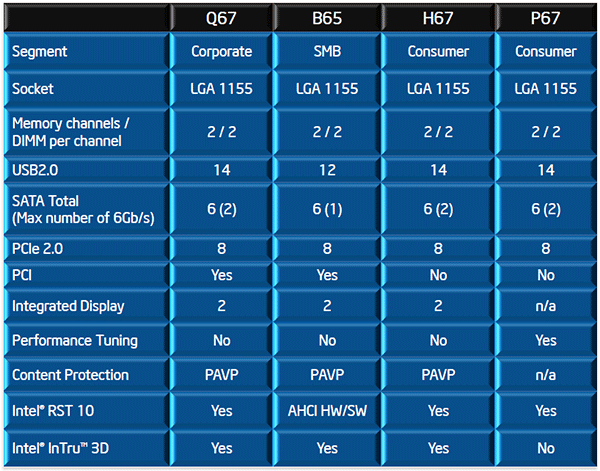Intel Core i7-2600K and i5-2500K Processors Debut
6-Series Chipsets, Intel Motherboards
To accompany the new Sandy Bridge Core i5 and i7 based processors, Intel is also introducing a whole family of chipsets—the 6-series. Above is a high-level block diagram of the flagship P67 chipset which is targeted at the performance and enthusiast segments, but there will be a number of other 6-series chipsets arriving as well, that target SMB and consumer segments. There will be mobile variants of each introduced coming down the pipeline too. The various 6-series desktop chipsets are listed above. They chipsets differ mainly in the number of USB and SATA 6Gps ports are supported, and in their support performance tuning, content protection, and RST 10 modes, but they are fundamentally very similar and all are actually based on the same die. Also note that the P67 does not support integrated display outputs, so Sandy Bridge’s integrated processor graphics is not available with the P67. We got our hands on a couple of Intel-built motherboards to test the new Sandy Bridge-based processors, the DH67BL (Bearup Lake) and DP67BG (Burrage). The DH67BL is a micro-ATX motherboard based on the H67 chipset, with full integrated display support. And the DP67GB is an enthusiast-class P67-based motherboard, sans display outputs. Both of the boards exploit all of the features inherent in the H67 and P67 chipsets and also feature NEC USB 3.0 controllers.

Intel P67 Chipset Diagram
The P67 chipset is essentially an I/O hub, as all of the traditional Northbridge functionality has been integrated into the processor itself. As you can see, Sandy Bridge processors offer 16 lanes of PCI Express 2.0 connectivity and they feature integrated dual-channel, DDR3 memory controllers. The processors are linked to the chipset via a 20Gb/s interface and the P67 itself it outfitted with 8 more PCIe 2.0 lanes, along with various other I/O, like USB 2.0, SATA, etc. The 6-series chipsets have native support for SATA 6Gbs, but not USB 3.0. USB is only available through the use of a third-party controller.




DH67BL (Bearup Lake - Left) and DP67BG (Burrage - Right)
For all of our graphics-related Sandy Bridge testing, the DH67BL was used. And we’ve got a full run of numbers utilizing the DP67BG as well, along with a few more using motherboards from Asus, MSI, and Gigabyte.






